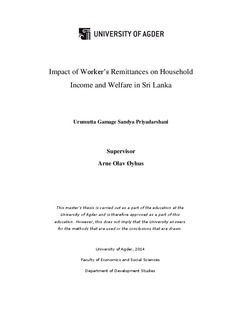| dc.contributor.author | Urumutta Gamage, Sandya Priyadarshani | |
| dc.date.accessioned | 2015-10-06T06:16:46Z | |
| dc.date.available | 2015-10-06T06:16:46Z | |
| dc.date.issued | 2014 | |
| dc.identifier.uri | http://hdl.handle.net/11250/2351451 | |
| dc.description | Master thesis development management- University of Agder, 2014 | nb_NO |
| dc.description.abstract | According to Economic and Social Statistic of Sri Lanka report in 2013, (p.21) the
foreign employment was recorded as 23.8% of total labour force in the 2010. The
total remittances income from abroad has risen steadily over the last years. As per
the report, the remittances from Middle East countries were SLRS (Mn) 428,593 and
it was SLRS (Mn) 335,387 from all other countries in 2012. Sri Lanka is struggling
to strike a balance between maximizing the development benefits of migration while
protecting migrant workers and their families from the adverse impacts of migration.
While Sri Lankan government currently faces some challenges on economic
development, other hand remittances have become as the second largest income
source of foreign exchange. Migration also affects negatively on the social life style
of migrants families and well as education & health of their children. Brain drain is
other negative impact (Economic and Social Statistic of Sri Lanka report 2013).
This study is based on the findings of a filed survey of 150 purposive samples of
Migrant Workers. The primary data was collected from the migrant itself and in case
of unavailability of migrant worker, the information were collected from one of the
family member of household. This survey has been carried out aiming two districts
in Sri Lanka (Kalutara and Colombo) where a major number of migrants are
departing for foreign jobs on yearly basis. It was aimed to investigate the impact of
worker’s remittances for household income and welfare. In particular, the study shall
also examine how such remittances have been able to contribute their income in
varies activities. In addition, I also investigate the effects of remittances on human
capital formation at the household level.
As per the findings, majority of the respondents have increased their family income
and well-being in migrant worker and their families. There are some positive and
negative effect on children’s’ education and health. This study mainly focuses to
investigate how migrant worker distribute their income in various ways. In addition
this thesis discusses some basic information regarding migration and remittances.
Further, it shall be briefly described on the history & services of SLBFE and
sustainable development by remittances. | nb_NO |
| dc.language.iso | eng | nb_NO |
| dc.publisher | Universitetet i Agder ; University of Agder | nb_NO |
| dc.subject.classification | UT 503 | |
| dc.title | Impact of Worker’s Remittances on Household Income and Welfare in Sri Lanka | nb_NO |
| dc.type | Master thesis | nb_NO |
| dc.subject.nsi | VDP::Social science: 200::Economics: 210::Business: 213 | nb_NO |
| dc.source.pagenumber | 106 s. | nb_NO |
